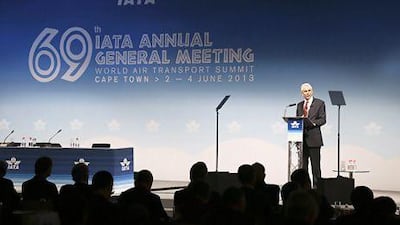Lower than expected fuel prices and a jump in the number of passengers flying in its planes have prompted the aviation industry to predict earnings will be 20 per cent higher this year than it was forecasting just three months ago.
The airlines' main representative body, the International Air Transport Association (Iata), yesterday estimated that airlines would record global net profits of US$12.7 billion this year, up from its March prediction of $10.6bn.
If achieved it would represent a 67 per cent increase in profits compared with $7.6bn last year. But the industry is still beset by wafer-thin profit margins and struggling to generate adequate returns for investors, said Iata's director and chief executive Tony Tyler during the group's annual meeting yesterday in Cape Town, South Africa.
He said airlines are set to carry more than 3 billion people this year, establishing a record with 80.3 per cent of the passenger seats being filled.
"Yet aviation's ability to generate sustainable returns continues to be challenging. This year we expect airlines to make $12.7bn profits. On $71bn in revenues, that's a 1.8 per cent net profit margin. And to put that into perspective, it means that we will earn a $4 profit per passenger carried, less than the price of a sandwich," said Mr Tyler.
"Generating even these small profits under current conditions is a major achievement. The price of fuel, our largest cost item, has increased 55 per cent since 2006. And we continue through the greatest period of economic stress since the 1930s."
An anticipated return on invested capital of about 4.8 per cent for the year will trail the 7 to 8 per cent average cost of capital required, raising doubts about airlines' ability to fund new and more efficient aircraft, Mr Tyler said.
"If airlines are to find the $4 trillion to $5tn needed to finance the projected fleet development over the next 20 years, even more improvements are needed."
Even so, carriers in all regions should post a profit this year, led by airlines in Asia with projected earnings of $4.6bn and North America with $4.4bn, he said.
European airlines should net income of $1.6bn, and Middle Eastern operators generate $1.5bn.
Carriers would continue to benefit from lower than expected fuel prices, with the average price of Brent crude oil this year expected to be $108 per barrel compared with $111.80 in 2012.
Africa is likely to remain the industry's poorest-performing region, with companies there returning a profit of just $100 million, the group predicted.
Mr Tyler said safety concerns were the largest obstacle that needed to be tackled to improve the African market. But with reduced estimates for global economic growth, Iata said the air-cargo market had all but stagnated.

